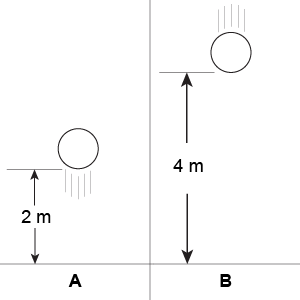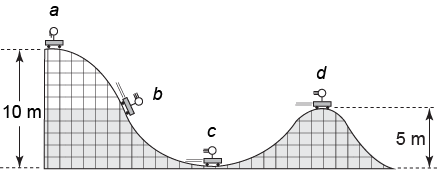|
The law of conservation of energy states that energy cannot be created or destroyed—only transformed. More specifically, the total energy remains constant in a closed system. An object’s mechanical energy is defined as the sum of its potential and kinetic energies, and it may remain constant in the absence of “frictional losses.” 
|
|
system, closed system, open system, law of conservation of energy, state
|
|
|
|
Review problems and questions |
|
- You shoot a 2.0 kg basketball toward the hoop with an initial total energy of 500 J. (Neglect air friction on the ball.)
- When the ball reaches the top of its arc, what is its total energy?
- When the ball is just about to hit the rim, what is its total energy?
- What principle are you demonstrating?


|
- Because of the law of energy conservation, the ball maintains its 500 J of total energy.
- Again, the total energy is conserved and is still 500 J.
- The problem demonstrates conservation of energy.

|

- Panel A shows a ball shortly after being tossed upward. Panel B shows the same ball at an instant on its way back down. Assume that air resistance can be ignored. Which statement is true?
- The potential and kinetic energy are both greater in Panel A than in Panel B.
- The potential and kinetic energy are both greater in Panel B than in Panel A.
- The potential energy is greater in Panel A, but the kinetic energy is greater in Panel B.
- The potential energy is greater in Panel B, but the kinetic energy is greater in Panel A.


|
Choice iv is correct. If air resistance is negligible, the ball constitutes a closed system. According to the law of conservation of energy, its mechanical energy (the sum of Ep and Ek) must remain unchanged. Since the ball is higher up in Panel B than in Panel A, its potential energy must be greater in B. That eliminates choices i and iii. Since its Ep is greater in Panel B, its kinetic energy must be smaller there—otherwise, the sum of Ep and Ek couldn’t stay the same. The correct statement is therefore choice iv. 
|

- A roller-coaster cart, initially stationary at position a, is given a gentle push to the right. As it glides along the track, it passes through positions b, c, and d. Assume that friction and air resistance can be ignored.
- At which of the four positions is gravitational potential energy greatest?
- At which position is the cart moving fastest?
- At which position(s) is/are potential and kinetic energy equal?


|
Answer: - position a
- position c
- positions b and d
Solution: The mechanical energy is constant for the roller-coaster cart since there are no dissipative forces (no friction or air resistance). This means that the sum of kinetic and gravitational potential energy remains unchanged: The lower the cart, the faster it goes, and vice versa. - Position a. Since the cart is highest here, it has the most gravitational potential energy in this position.
- Position c. Since the cart is lowest here, it has the least gravitational potential energy. But mechanical energy is conserved, so the lost potential energy must have been transformed to kinetic energy. Therefore the cart travels fastest at this position.
- Positions b and d. At these positions, the cart is 5 m above the zero point—half the original height. Gravitational potential energy is proportional to height, so the cart has given up half of its potential energy in positions c and d. The other half must be in the form of kinetic energy, since there is no friction or air resistance to turn it into heat. Consequently, the cart has equal amounts of kinetic and gravitational potential energy in these two positions.

|
- A ball is dropped from two heights, one four times as high as the other. What is the ratio of the speeds in the two cases just before the ball hits the ground? (Assume that air resistance can be ignored.)


|
Answer: A ball dropped from four times the height will have twice the speed. The higher drop position provides four times as much gravitational potential energy to the ball. All this energy is converted to kinetic energy just before the ball hits the ground. Therefore, at ground level the high ball gets four times the kinetic energy of the low ball. But kinetic energy is proportional to the square of speed. Thus the ratio of speeds is 2:1. In algebraic form, this is Taking the ratio of the two velocities yields

|
Take a Quiz |

